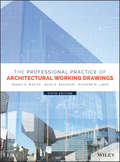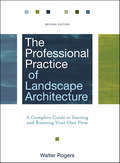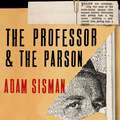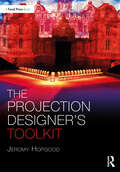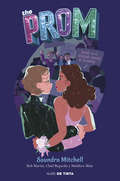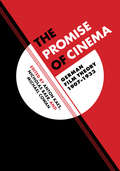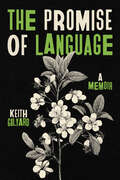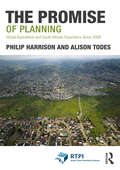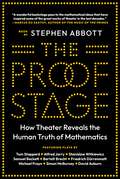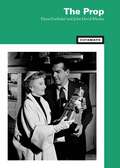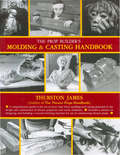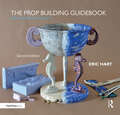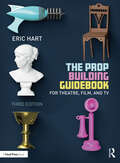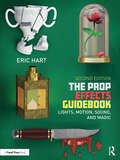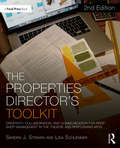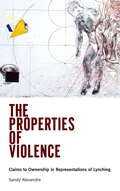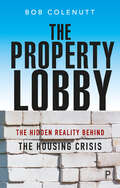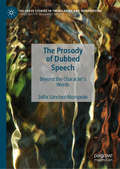- Table View
- List View
The Professional Practice of Architectural Working Drawings
by Osamu A. Wakita Richard M. Linde Nagy R. BakhoumThe detailed, highly illustrated, comprehensive guide to architectural working drawings The Professional Practice of Architectural Working Drawings is a complete guide to the skills you need to create a set of drawings that clearly and effectively communicate your design. Covering everything from site, floor, framing, and foundation plans to building sections and elevations, this book presents crucial concepts and real-world techniques architects rely on every day. You'll learn the standards, customs, regulations, and symbols, alongside computer-generated drawings, 3D modeling, Building Information Modeling, and other architectural technology. This new fifth edition includes updated information on sustainability concepts, layering systems in line with AIA standards, deeper explorations of dimensioning, more sample ADA drawings, and a new selection of case studies that offer a real-world glimpse into how these topics relate to the architect's everyday work. Hundreds of drawings demonstrate important skills and concepts, and online ancillary materials offer a robust set of resources to students and instructors. Architectural drawings must be precise, accurate, and complete; they must follow certain standards that make them universally understood in the proper context. This book teaches you how to produce professional-level drawings that leave no room for questions or confusion. Create architectural drawings that effectively communicate your design Learn techniques used in both residential and light commercial projects Investigate BIM, 3D modeling, and other architectural technologies Understand dimensioning, sustainability, ADA standards, and more Architects use drawings as a second language, to effectively communicate ideas to clients, contractors, builders, and other design professionals throughout all stages of the project. The Professional Practice of Architectural Working Drawings teaches you how to become fluent in the visual language of architecture, to communicate more effectively with all project stakeholders.
The Professional Practice of Landscape Architecture
by Walter Rogers Michaal DollinThe all-inclusive reference to starting and operating a landscape architecture firm The Professional Practice of Landscape Architecture, Second Edition is completely revised to keep up with the latest developments driving the day-to-day operation of a successful private-practice landscape architecture office. Whether helping a landscape architecture student identify a career track, providing direction on starting a new office, guiding an owner seeking to jumpstart a stagnant or fledgling business, or assisting a landscape architect-in-training study for the national Landscape Architecture Registration Exam (LARE), this single-source blueprint is the key to prospering in this dynamic field. This new edition features: Indispensible information for practicing landscape architects, including professional ethics, finances, office administration, marketing and promotion, and project management An updated look at government regulatory laws, federal tax administration, sustainable design, and LEED certification Strategies for using the Internet, computer software, and technology to market and manage a firm Examples of professional contract templates Case study profiles of landscape architecture firms Requirements for professional registration and criteria for taking the national exam This comprehensive and practical reference combines real-world experience with the highest professional standards to instruct the reader on business concepts. Expertly organized and easy to follow, The Professional Practice of Landscape Architecture, Second Edition continues to be the one source that landscape architects need to direct all facets of their practice.
The Professionalization of Intelligence Cooperation: Subverting The Social Order (Crime Files)
by Adam D.M. SvendsenPresenting a social history of British crime film, this book focuses on the strategies used in order to address more radical notions surrounding class, politics, sex, delinquency, violence and censorship. Spanning post-war crime cinema to present-day "Mockney" productions, it contextualizes the films and identifies important and neglected works.
The Professor and the Parson: A Story of Desire, Deceit and Defrocking
by Adam SismanOne day in November 1958, the celebrated historian Hugh Trevor-Roper received a curious letter. It was an appeal for help, written on behalf of a student at Magdalene College, with the unlikely claim that he was being persecuted by the Bishop of Oxford. Curiosity piqued, Trevor-Roper agreed to a meeting. It was to be his first encounter with Robert Parkin Peters: plagiarist, bigamist, fraudulent priest and imposter extraordinaire.The Professor and the Parson traces the strange career of one of Britain's most eccentric criminals. Motivated not by money but by a desire for prestige, Peters' lied, stole and cheated his way to academic positions and religious posts from Cambridge to New York, Singapore and South Africa. Frequently deported, and even more frequently discovered, his trail of destruction included seven marriages (three of which were bigamous), an investigation by the FBI and a disastrous appearance on Mastermind.Based on Trevor-Roper's own detailed 'file on Peters', The Professor and the Parson is a witty and charming account of eccentricity, extraordinary narcissism and a life as wild and unlikely as any in fiction.
The Profitable Artist: A Handbook for All Artists in the Performing, Literary, and Visual Arts
by ArtspireWhile all art is unique, the challenges artists face are shared regardless of background, experience, and artistic medium. <P><P>With decades of experience training and helping artists, the expert staff of the New York Foundation for the Arts have compiled a "best practices" approach to planning and organizing an art career. In this book, NYFA has identified common problems, examined specialized areas of business, ?nance, marketing, and law, and distilled these topics in such a way that readers can digest them and apply them to their own experience and practice. Included are interviews, anecdotes, and in-depth case studies. The skills and guidelines in The Pro?table Artist will also translate effectively to teaching and mentoring opportunities that artists may encounter as their career progresses. This invaluable guide appeals to all artists in all disciplines of the literary, media, performing, and visual arts, from recent art school graduates to established artists undertaking new arts businesses to artists seeking more from their careers at any stage of their career.
The Profitable Artist: A Handbook for All Artists in the Performing, Literary, and Visual Arts (Second Edition)
by New York Arts Peter Cobb Felicity Hogan Michael RoyceThe Indispensable Roadmap Artists Need to Navigate Their Careers While all art is unique, the challenges artists face are shared regardless of background, experience, and artistic medium. With decades of experience training and helping artists worldwide, the expert staff of the New York Foundation for the Arts—in conjunction with outside professionals—have compiled a “best practices” approach to planning and organizing an art career. In The Profitable Artist, Second Edition, NYFA has identified common problems, examined specialized areas of strategic planning, finance, marketing, law, and fundraising, and distilled these topics in such a way that readers can digest them and apply them to their own experience and practice. This newly revised edition has made considerable updates to reflect changes in the legal and financial landscapes, the vast shift in the tools and culture of both social media and fundraising, and proven planning methodologies from the startup community. All of this continues to be presented in an accessible manner, which encourages artists to apply the information and techniques in a way that is true to their personal and artistic integrity. This invaluable guide appeals to artists in all disciplines of the literary, media, performing, and visual arts—from recent art school graduates to established artists undertaking new arts businesses to artists seeking more from their careers at any stage.
The Projected Nation: Argentine Cinema and the Social Margins (SUNY series in Latin American Cinema)
by Matt LosadaThe Projected Nation examines the representation of rural spaces and urban margins in Argentine cinema from the 1910s to the present. The literary and visual culture of the nineteenth and early-twentieth centuries formulated a spatial imaginary—often articulated as an opposition between civilization and barbarism, or its inversion—into which the cinema intervened. As the twentieth century progressed, the new medium integrated these ideas with its own images in various ways. At times cinema limited itself to reproducing inherited representations that reassure the viewer that all is well in the nation, while at others it powerfully reformulated them by filming spaces and peoples previously excluded from the national culture and left behind in the nation's modernizing process. Matt Losada accounts for historical events, technological factors, and the politics of film form and viewing in assessing a selection of works ranging from mass-marketed cinema to the political avant-garde, and from the canonical to the nearly unknown.
The Projection Designer’s Toolkit (The Focal Press Toolkit Series)
by Jeromy HopgoodThe Projection Designer’s Toolkit is an insider’s guide to the world of professional projection design, serving as a reference for the planning and execution of each step in the projection design process. The text addresses the design process within the context of a professional projection designer’s workflow, focusing on specific tools of the trade, best practices for communicating your design to collaborators, tips and tricks, determining budget, working with assistants, and more. Featuring interviews with some of the top names in the industry, the book offers an unprecedented insight into the professional projection designer’s process across a wide range of fields, from Broadway and regional theatre to corporate design and music touring. The book also includes in-depth discussion on production process, system design, cue and content planning, content design, digital media fundamentals, media servers, video equipment, and projection surfaces. Additionally, it features hundreds of full-color photos and examples of designer artifacts such as draftings, mock-ups, paperwork, cue sheets, and renderings. Filled with practical advice that will guide readers from landing their first job all the way through opening night and beyond, The Projection Designer’s Toolkit is the perfect resource for emerging projection designers and students in Digital Media Design and Projection Design courses.
The Prom
by Saundra Mitchell Chad Beguelin Matthew SklarLlega la novela de la nueva apuesta de Netflix: la adaptación del éxito de Broadway The Prom. Emma Nolan tiene quince años y solo sueña con una cosa en este mundo: bailar con su novia en el baile de graduación. Pero en su pequeño pueblo de Edgewater, Indiana, eso es como pedir la luna. Alyssa Greene es la chica más conocida del instituto, la más popular, jefa del consejo estudiantil e hija de la presidenta de la asociación de padres. Pero esconde un secreto: su relación con Emma. Cuando se corre la voz de que Emma planea llevar a una chica al baile, es tal el alboroto, que la asociación de padres amenaza con cancelarlo. Todo eso ocurre antes de que entren en acción Barry Glickman y Dee Dee Allen, dos estrellas de Broadway que deciden asumir la causa para obtener un poco de publicidad a cambio. Pero cuando llegan a Indiana para enarbolar la lucha en nombre de Emma, sus buenas intenciones se tuercen por completo. Con Emma enfrentada a los prejuicios de cabeza, Alyssa sumida en la duda sobre si salir del armario y Barry y Dee Dee disfrutando de toda la atención mediática, la tormenta perfecta está a punto de estallar. Sin embargo, cuando consiguen ir a la una, se dan cuenta de que siempre vale la pena luchar por el amor.
The Promise of Cinema
by Anton Kaes Nicholas Baer Michael CowanRich in implications for our present era of media change, The Promise of Cinema offers a compelling new vision of film theory. The volume conceives of "theory" not as a fixed body of canonical texts, but as a dynamic set of reflections on the very idea of cinema and the possibilities once associated with it. Unearthing more than 275 early-twentieth-century German texts, this ground-breaking documentation leads readers into a world that was striving to assimilate modernity's most powerful new medium. We encounter lesser-known essays by Béla Balázs, Walter Benjamin, and Siegfried Kracauer alongside interventions from the realms of aesthetics, education, industry, politics, science, and technology. The book also features programmatic writings from the Weimar avant-garde and from directors such as Fritz Lang and F.W. Murnau. Nearly all documents appear in English for the first time; each is meticulously introduced and annotated. The most comprehensive collection of German writings on film published to date, The Promise of Cinema is an essential resource for students and scholars of film and media, critical theory, and European culture and history.
The Promise of Language: A Memoir (African American Life)
by Keith GilyardRecounting a life—and language—by an esteemed scholar of African American rhetoric. In this powerful coming-of-age memoir, author, scholar, and linguist Keith Gilyard presents a testament to the transformative power of language. From his earliest days in the segregated New York City public schools of the 1950s and '60s through his ascent in academia, the rhythm of Black America's vernacular and music provides the backdrop to Gilyard's intellectual awakening. He absorbed language through music, television, and radio, recognizing early on that his mother was a "language chameleon," a woman from Georgia who never sounded Black southern. His journey intertwines personal growth with the multiplicity of language and the sociopolitical upheavals of the Cold War era and the Civil Rights, Black Power, and Black Arts movements. Through vibrant anecdotes and introspection, Gilyard brings his experiences and realizations to life from memories of barbershops, churches, and schools, to lessons from mentors and influencers like Ed Bullins, Sonia Sanchez, Don L. Lee (later Haki Madhubuti), Toni Morrison, and Paule Marshall. Each encounter brings clarity and a new lens through which to understand the world, revealing how language shapes our lives and how our lives are shaped by language.
The Promise of Planning: Global Aspirations and South African Experience Since 2008 (ISSN)
by Alison Todes Philip HarrisonThe Promise of Planning explores the experience of planning internationally since the global financial crisis, focusing on South Africa. The book is a response to a decade-plus in which state-led planning has re-emerged as a putative means for achieving developmental goals (as indicated in global initiatives such as the New Urban Agenda) and where planning in South Africa has consolidated in terms of its legal and policy basis. However, the return of planning is happening in an inauspicious context, with economic fragilities, technological shifts, political populism, institutional complexities, and more, threatening to upturn the "new promise of planning." The book provides a careful analytical account of planning in South Africa and how and why its promises have been difficult to achieve. Building on the authors’ previous book, Planning and Transformation, the book sheds light on planning as an increasingly complex and diverse governmental practice within a perpetually changing world. It can be used as a resource for planners who must make good on the new promise of planning while navigating the risks and threats of the contemporary world, as well as students and faculty interested in international planning debates and the South African case.
The Promise: The Moving Story of a Family in the Holocaust
by Barbara PowersA Holocaust survivor's own story, told specially for young readers.This is the remarkable true story of a young Jewish girl and her brother caught in a world turned upside down by the Nazis during the Second World War. Eva Schloss describes her happy early childhood in Vienna with her kind and loving parents and her older brother Heinz, whom she adored. But when the Nazis marched into Austria everything changed.Eva's family fled to Belgium, then to Amsterdam where, with the help of the Dutch Resistance, they spent the next two years in hiding - Eva and her mother in one house, and her father and brother in another. But in the end they were all betrayed and deported to Auschwitz concentration camp in Poland. Despite the horrors of the camp, Eva's positive attitude and stubborn personality (which had often got her into trouble) saw her through one of the most tragic events in history but sadly her father and brother perished just weeks before the liberation. Eva and her mother travelled back to the house in Amsterdam where Heinz and his father had hidden and discovered over thirty beautiful paintings by her brother. Heinz hadn't wasted any of his talents during his captivity. For Eva, here was a tangible, everlasting memory of her beloved older brother, and a reminder of her father's promise that all the good things you accomplish will make a difference.Heinz's paintings have been on display in exhibitions in the USA and are now a part of a permanent exhibition in Amsterdam's war museum.Eva Schloss is the posthumous step-sister of Anne Frank, after mother, Fritzi, was remarried to Otto Frank, the only surviving member of his immediate family.
The Proof Stage: How Theater Reveals the Human Truth of Mathematics
by Stephen AbbottHow playwrights from Alfred Jarry and Samuel Beckett to Tom Stoppard and Simon McBurney brought the power of mathematics to life on the stageThe discovery of alternate geometries, paradoxes of the infinite, incompleteness, and chaos theory revealed that, despite its reputation for certainty, mathematical truth is not immutable, perfect, or even perfectible. Beginning in the last century, a handful of adventurous playwrights took inspiration from the fractures of modern mathematics to expand their own artistic boundaries. Originating in the early avant-garde, mathematics-infused theater reached a popular apex in Tom Stoppard&’s 1993 play Arcadia. In The Proof Stage, mathematician Stephen Abbott explores this unlikely collaboration of theater and mathematics. He probes the impact of mathematics on such influential writers as Alfred Jarry, Samuel Beckett, Bertolt Brecht, and Stoppard, and delves into the life and mathematics of Alan Turing as they are rendered onstage. The result is an unexpected story about the mutually illuminating relationship between proofs and plays—from Euclid and Euripides to Gödel and Godot.Theater is uniquely poised to discover the soulful, human truths embedded in the austere theorems of mathematics, but this is a difficult feat. It took Stoppard twenty-five years of experimenting with the creative possibilities of mathematics before he succeeded in making fractal geometry and chaos theory integral to Arcadia&’s emotional arc. In addition to charting Stoppard&’s journey, Abbott examines the post-Arcadia wave of ambitious works by Michael Frayn, David Auburn, Simon McBurney, Snoo Wilson, John Mighton, and others. Collectively, these gifted playwrights transform the great philosophical upheavals of mathematics into profound and sometimes poignant revelations about the human journey.
The Prop (Cutaways)
by John David Rhodes Elena GorfinkelWhat are film props? What do they do? This book answers these questions by a close attention to those material objects that are used to construct cinematic worlds. The term “prop” is short for property. This truncated term’s etymology belies the expansiveness of the concept and indicates the micro and macro scales at which the prop operates. Props are the material—often literal—furniture of cinema’s diegetic reality. Props are also narrative agents: think of the animacy of objects in Jean Epstein’s account of photogénie, the crystal egg in Risky Business, or the domestic bric-à-brac of Sirk’s melodramas. The prop is central to production design and the construction of mise-en-scène. And yet, the prop has rarely—almost never—been taken as an object of analysis and theorization in its own right. This book begins by tracing the prop’s curious but unacknowledged role in film theory, before proceeding to a series of theoretical speculations and close readings that bring the prop into focus. Analyses of scenes of “prop mastery” demonstrate the labor that props perform and enable, as well as the interpretive work they make possible. Across a variety of genres, modes, and historical contexts—studio filmmaking, art cinema, adult and avant-garde films—The Prop introduces readers to the notion of “prop value,” a quality that puts the prop in proximity to the capitalist commodity, but also provides an ironic distance from the commodity’s subjection to exchange value. Gorfinkel and Rhodes argue that the prop is nothing less than a condensation of how labor, subjection, value, and instrumentality underwrite the very conditions of cinema.
The Prop Builder's Molding & Casting Handbook (Technical Theatre, Film And Television Ser.)
by Thurston JamesThe Prop Builder's Molding & Casting Handbook This is the first book to contain, in one comprehensive volume, every molding and casting procedure of use to the theater props builder (no matter what his or her level or proficiency). The author demonstrates the techniques involved in using more than thirty different materials ranging from papier-mache to breakaway glass. While the use of some materials–plaster and polyester resins, for example–is covered to some extent in other publications, information on the selection and use of rubber materials (latex, neoprene, silicone, and the urethanes) and the procedure for making breakaway windows and bottles is available only in The Prop Builder's Molding & Casting Handbook. Written in an easy, conversational style, the book will be useful to anyone involved with theater properties, puppetry, and costuming (as professionals or amateurs). It will also serve admirably the needs of students taking classes in those subjects. Completing the book is a special section on designing and building a vacuum forming machine suitable for use in constructing theater props. More than 450 photographs illustrate the step-by-step procedures explained throughout the entire text.
The Prop Building Guidebook: For Theatre, Film, and TV
by Eric HartExperienced prop maker Eric Hart walks readers through techniques used in historical and contemporary prop making and demonstrates how to apply them to a variety of materials. Hundreds of full-color photographs illustrate the tools and techniques used by professional prop makers throughout the entertainment industry. New features to the second edition include: Updated information on the latest tools and materials used in prop making Both metric and standard measuring units Step-by-step photos on common techniques such as upholstery, mold making, and faux finishing Expanded coverage of thermoplastics, foam, and water-based coatings
The Prop Building Guidebook: For Theatre, Film, and TV
by Eric HartNow in its third edition, The Prop Building Guidebook: For Theatre, Film, and TV walks readers through techniques used in historical and contemporary prop making and demonstrates how to apply them to a variety of materials. Experienced prop maker Eric Hart covers the tools and techniques used by professional prop makers throughout the entertainment industry. He outlines a construction process that gives readers the foundational knowledge to choose the best materials and methods for each prop and the background information to know the advantages of these choices. This new edition includes updated information and techniques throughout, including: Over a hundred new images and diagrams Updated terminology, products, and brands used internationally Expanded sections on 3D printing, vacuum forming, foam patterning, and more A new chapter on prop design New information on international safety standards, cleaning, and sanitation More recipes and step-by-step instruction for various finishes Illustrated by hundreds of full-color photographs, this is the most comprehensive guide to prop construction available for professional and student prop makers in theatre, film, and tv. For additional how-to videos, instructional documents, and supplemental information, visit www.propbuildingguidebook.com.
The Prop Effects Guidebook: Lights, Motion, Sound, and Magic
by Eric HartIn The Prop Building Guidebook, author Eric Hart demonstrated how to cut, glue, sculpt, and bend raw materials to build props. Now in The Prop Effects Guidebook, he shows us how to connect and assemble components and parts to make those props light up, explode, make noise, and bleed. It delves into the world of electricity, pneumatics, liquids, and mechanical effects to teach you how to make your props perform magic in front of a live audience. The book is complemented by a companion website featuring videos of how to create individual prop special effects: www.propeffectsguidebook.com.
The Prop Effects Guidebook: Lights, Motion, Sound, and Magic
by Eric HartThe Prop Effects Guidebook Second Edition explores how to make props for the stage that move, light up, make sounds, or interact with their environment. Whether it's a sword that glows, a vase that breaks, or a book that bursts into flames (safely), this guide shows how to bring imagination to life.The book covers practical techniques using everyday tools and materials. It explains concepts like electricity, mechanics, and pneumatics in simple terms, making them accessible even for beginners. Nearly 300 photographs, illustrations, and charts help readers understand how to build dynamic effects. In this second edition, each chapter has been updated with new technology and detailed and advanced information, more illustrative photographs and diagrams, new information on virtual prototyping methods, LED and wireless lighting technology, app-based controllers, more examples of drops, blood delivery methods, flicker effects, sound effects, and much more. The Prop Effects Guidebook bridges creativity and engineering, showing how to solve problems and adapt designs for different situations.Groundbreaking in its comprehensive approach, this guide empowers students in Prop Building courses, artists, educators, and hobbyists to create magic on stage, making it an invaluable resource for anyone with a passion for storytelling and craftsmanship.The book is complemented by a companion website featuring videos of how to create individual prop special effects: www.propeffectsguidebook.com.
The Properties Director's Toolkit: Managing a Prop Shop for Theatre (The Focal Press Toolkit Series)
by Sandra Strawn Lisa SchlenkerThe Properties Director’s Toolkit is a concise guide to managing a prop shop and show build. Sandra Strawn and Lisa Schlenker skilfully explain and provide templates for organizing and managing a prop shop, from pre-production organization to production processes, budgeting and collaborations with other production areas. The Toolkit also explores how to plan, organize and maintain a prop shop for safe and efficient production work. This thoroughly revised second edition includes two additional chapters on the role of the Props Director and co-productions, along with expanding information in each chapter, including artisan responsibilities, union information, digital collaboration, prop shop organization and construction, and projections.
The Properties of Violence: Claims to Ownership in Representations of Lynching
by Sandy AlexandreThe Properties of Violence focuses on two connected issues: representations of lynching in late-nineteenth and twentieth-century American photographs, poetry, and fiction; and the effects of those representations. Alexandre compellingly shows how putting representations of lynching in dialogue with the history of lynching uncovers the profound investment of African American literature—as an enterprise that continually seeks to create conceptual spaces for the disenfranchised culture it represents—in matters of property and territory. Through studies ranging from lynching photographs to Toni Morrison's Pulitzer Prize-winning novel, Beloved, the book demonstrates how representations of lynching demand that we engage and discuss various forms of possession and dispossession. The multiple meanings of the word “representation” are familiar to literary critics, but Alexandre's book insists that its other key term, “effects,” also needs to be understood in both of its primary senses. On the one hand, it indicates the social and cultural repercussions of how lynching was portrayed, namely, what effects its representations had. On the other hand, the word signals, too, the possessions or what we might call the personal effects conjured up by these representations. These possessions were not only material—as for example property in land or the things one owned. The effects of representation also included diverse, less tangible but no less real possessions shared by individuals and groups: the aura of a lynching site, the ideological construction of white womanhood, or the seemingly default capacity of lynching iconography to encapsulate the history of ostensibly all forms of violence against black people.
The Property Lobby: The Hidden Reality Behind the Housing Crisis
by Bob ColenuttIn this accessible and passionately argued book, Bob Colenutt goes to the roots of the long-term crisis in housing and planning in the UK. Providing a much-needed, in-depth critique of the nexus of power of landowners, house builders, financial backers and politicians that makes up the property lobby, this radical book reveals how this complex, self-serving and intimidating network perpetuates a cycle of low supply, high prices and poor building which has resulted in one of the biggest social and economic challenges of our time. With radical ideas for solutions, this is essential reading for anyone with an interest in housing, planning and social justice.
The Prosody of Dubbed Speech: Beyond the Character's Words (Palgrave Studies in Translating and Interpreting)
by Sofía Sánchez-MompeánThis book offers a descriptive and practical analysis of prosody in dubbed speech, examining the most distinctive traits that typify dubbed dialogue at the prosodic level. The author's unique perspective - as both a translation studies researcher and a voice-over professional - helps to bring these two aspects of the dubbing process together into a coherent study for the first time. Supported by corpus analysis of English and Spanish episodes of US TV show How I Met Your Mother, she examines aspects of prosody in source and target languages, including features such as intonation, loudness, tempo, rhythm and tension. This book will be of interest to students and scholars of translation and interpreting, media studies, television and film production, as well as dubbing professionals.
